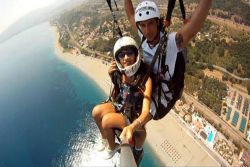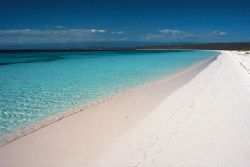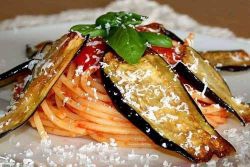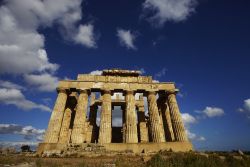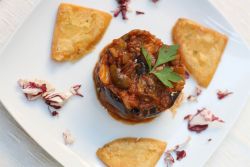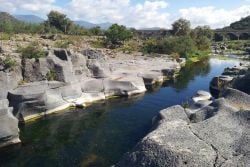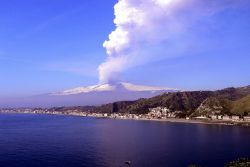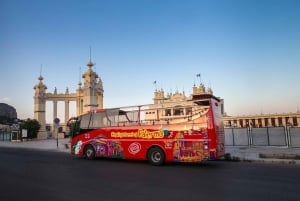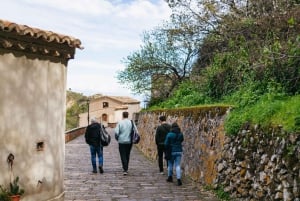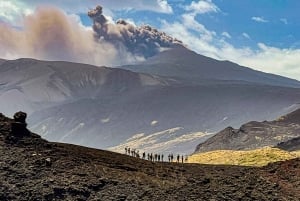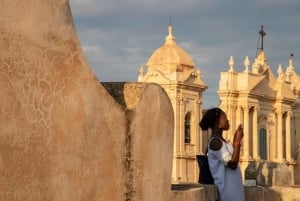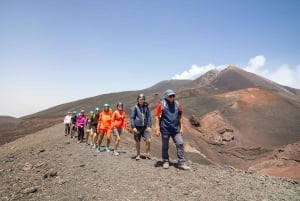TOP 10 Things To Do, See and Know in Sicily
In Sicily there are several TOP 10s, not only one. TOP 10 Things To Do, TOP 10 Beaches, TOP 10 Things To Eat, TOP 10 Things To Do With Children and so on...... Our TOP 10s are admittedly subjective (only a little bit) and the choices were not easy, in particular the TOP 10 Beaches, because there are the most beautiful beaches everywhere, the long sandy ones in the south and the west, sloping gently into the sea and perfect for children. Rocky bays with pebbles, which are great for snorkelling, black lava stone beaches like in Catania, the lagoon of Marsala which is perfect for kite surfing, lively Mondello, and and and...and Sicily boasts about 1000 km of coastline!
Also the TOP 10 choice of things to eat turned out to be a bit complicated because everything Sicilians "concoct" is simply yummy, and they concoct a lot. And every province and town has their own specialties and recipes. Here you can learn more about Sicilian cuisine and recipes.
We are always grateful for tips and would appreciate it if you would help us to complete this page. Tell us about your favourite dish and where you tried it, send a photo, let us know when you discovered something great to do with children, a deserted beach or a lovely church in a village, or maybe you have an idea for more TOP 10s. Please send e-mail to sabine.schroeder@mydestination.com
We are still working on this page, so check from time to time for TOP 10 newcomers
TOP 10 Hikes
Wherever you are in Sicily, a natural beauty is not far away. Mountains, salt marshes, lakes, gorges, steaming craters, rivers, grottoes and caves are spread over the island(s). Our ten top spots are to be discovered on foot. Required: sunscreen with a high SPF, mineral water, hat, sturdy shoes or walking boots. Not required: a guide, except on the island of Stromboli. Please keep in mind that most of Sicily’s hiking and trekking trails are not or poorly signed. We suggest starting the hikes early in the morning before it gets too hot.
Fossa di Vulcano – Aeolian Islands
Cava d'Ispica - Modica
Silvestri Craters - Mount Etna
Stromboli - Aeolian Islands
The Giant Holly Trees of Piano Pomo
Piano Battaglia
Pantàlica - UNESCO World Heritage Site
From Taormina up to Castelmola
Fiume Platani
The Small Alcantara Gorges
See detailed descriptions here
Top 10 Things To Do - 1 Must & 9 Shoulds
Explore Mount Etna
The wonderful looming spectre of Mount Etna, rising dramatically above Catania and the towns on the eastern coast, is also a fantastic playground for those who like adventure and activities. Here you can ski in winter, hike or bike in every other season and also go horse riding. If you have time, taste some of the wine that is produced on the slopes of Mount Etna. If you are not the adventurous or sporty type book an organized excursion by bus to the cable car station and/or an off-road-tour to the most picturesque areas and lunar landscapes.
Enjoy an evening in an ancient amphitheatre
From June to September the Taormina Arte Festival takes place in Taormina, offering a wide range of theatre and dance performances, opera, classic, rock and pop concerts. Grand opening every year is the Taormina Film Fest – one week the newest movies. The atmosphere in the amphitheatre is unbeatable: sitting under the star-spangled sky, with a fire spitting Mount Etna in the background. Visitors to Syracuse can enjoy in May the Greek tragedies in the amphitheatre which was constructed for these tragedies. And visitors staying in Palermo, Trapani and Mazara del Vallo could go to Segesta and spend a pleasant evening in the Greek theatre.
Hang out with Montalbano
Montalbano was (and still is) one of Italy’s most popular television shows about the life of Inspector Salvo Montalbano: beautiful women, bizarre types, Sicilian food, sometimes a bit weird colleagues, Mafia, murder and crime. If you’re a fan of the series a highlight of your visit to Sicily will no doubt be visiting places used as locations in the show such as Agrigento, Tindari, Ragusa Ibla, Licata and Punta Secca. Most of the shooting spots are in Sicily’s west, in and around Agrigento and in the province of Ragusa. Just keep in mind that the places in Andrea Camilleri’s novels are often not the ones of the TV show.
Wine Tasting
Your holidays won’t be complete without a visit to a Sicilian winery. Wherever you stay or go, there will be a winery not far away, be it a big one that produces awarded drops like Planeta, or a small one producing only for the local market. You could even spend your holidays in a winery and transform your entire holiday in a wine tasting. Vineyards are scattered all over Sicily, more than 10 different types of grapes are cultivated on the island. What about a wine tour along one of the “wine roads”?
Celebrate with the locals
Throughout the year Sicily celebrates, there are big religious and historical festivals and small village festivals. These festivals are a great way to know people, listen to Sicilian folk music and taste local specialties. If there is nothing special in the culinary sector about their place Sicilians simply celebrate their patron saint, which is in doubt Saint Joseph (San Giuseppe). Every festivity finds a glorious end in spectacular artificial fireworks, which are mostly not notable for their artistic execution but for the noise - they got to beat the neighbouring village.
For yearly events check our Festival Calendar, current events you'll find here
Visit an island or three
While Sicily itself is an island don’t forget it is surrounded by smaller islands which are simply delightful. To the north are the beautiful Aeolian Islands famed for their thermal activity, picturesque villages, good hiking, fishing and eating possibilities. Easily reachable from Palermo is Ustica, which boasts the most beautiful underwater world, and is renowned for diving. The Egadi Islands to the west offer excellent swimming and diving opportunities, and wonderful panoramas of unspoilt land and seascapes. Pantelleria lies to the south and is the most isolated of the Sicilian islands. It has bronze age villages, sweet wines and a distinct Arab influence in the population and architecture. A brief description of all islands can be found here
Discover Sicily’s wonderful natural attractions
Sicily has a number of fantastic wilderness areas, including the Parco Regionale delle Madonie, Parco dei Nebrodi and Parco Regionale dell'Etna. These are great places to walk, bike, ski and enjoy the wildlife, and each is significantly different from the rest. You can explore ancient cave tombs in Pantàlica, prehistoric caves near Palermo and a Phoenician settlement on the islet of Mozia, experience the salt marshes of Trapani and the lagoon of Marsala, watch birds in Vendicari and Zingaro, botanize on Mount Etna and in Cavagrande di Cassibile, do canyoning in the Alcantara River Park or simply enjoy swimming in the crystal clear waters in the park of Belice (and elsewhere of course). Divers will appreciate the colourful underwater world – best places: Ustica, Capo Taormina, the Aeolian Islands, the Egadi Islands, Cefalù and the Cyclops Coast.
Sicily's nature parks and natural reserves, town parks and gardens
Rent A Car – Bicycle – Scooter
Exploring Sicily by car is the best way for independant people, families and small groups. Before you head out on four wheels have a look on our page Driving in Sicily. Sporty travellers should hire a mountain bike, not so sporty ones simply rent a city bike which is great for city strolls on two wheels e.g. in Trapani and Siracusa. In Palermo you could even book a sightseeing tour by bicycle! If you want to get the real Italian feel: rent a scooter.
Take in the activity of an outdoor market
La Pescheria is a fish market held every morning in the vibrant square below the cathedral of Catania. Here you could pick up a good bargain on a fresh catch, watch the fishmongers displaying their (sometimes still wriggling) wares, snap a few good images or even eat a wonderful meal. Palermo boasts several colourful outdoor markets which are open until late evening, the best known (and also most touristic) is La Vucciria. More characteristic are Il Capo and Ballarò. On all markets it is essential to try the local street food. Warning: some Palermitan specialties are only for adventurous and/or brave eaters!
Do something very pleasant – go shopping
Sicily boasts some of the largest shopping centres in Italy, if not in Europe, which are mostly to be found in big cities like Palermo and Catania. For bargains of designer clothing, shoes and accessories you should pay a visit to the Sicilia Outlet Village in Enna – up to 70% discount the whole year. In historical centres you will find small cute shops, selling culinary specialties, handmade ceramics, leatherwear and jewellery, hats (the famous coppolas and borsalinos), and much more.
Be a time traveller
Tours to the picturesque and sleepy villages and small towns in the Madonie and Nebrodi mountains is like a travel through time back to the Middle Ages and will make for unforgettable memories, great photos and panoramic views. Gangi, Sperlinga, Castelbuono, Montalbano Elicona, Savoca and Forza d’Agrò are only some places well worth visiting when you are staying in the northern and eastern part of Sicily. Not far from Syracuse, in the Hyblaean mountains, you can experience rural Sicilian life of past times in the village-museum of Buscemi. Baroque aficionados should concentrate on the triangle Noto-Ragusa-Modica, and for those who want to get the Arab feel there are Trapani and Mazara del Vallo.
Top 10 Beaches
A choice that was not easy.....
Mondello
Mondello nestles between Monte Pellegrino and Monte Gallo, few kilometres from Palermo. Think soft white sand and deep azure and crystal clear sea beds. It is a busy resort with fashionable shops in pleasant pedestrians streets, some hotels, plenty of bars, restaurants and ice cream stands all lined up around the beach offering fresh and extremely tasty seafood dishes, refreshing drinks and Sicilian ice cream.
San Vito Lo Capo
San Vito’s best attraction must be the beach which is often compared to those of the Caribbean. The crystal clear warm sea waters bathe the dazzling white and delicate sand, all of which is overlooked by a heavenly clear blue sky with not a single cloud in a sight. We would strongly recommend this beach for kids and families as the sea is tranquil and the waves are very gentle.
Mazzarò
The beach of Mazzarò is nestled in a scenic bay and framed by rocks, easily reachable by cable car from Taormina. It is quite small, but certainly one of the most beautiful locations in the whole of Sicily. The sand is coarse with pebbles of small and medium size, both on the beach and in the water, so bring water shoes. But the unique location makes up for it.
Portopalo di Capo Passero
The beaches of Portopalo di Capo Passero are wonderful, white and golden sand washed by a crystal clear sea in all shades of green from light turquoise to emerald. For your beach days you should bring a picknick, something to drink and a parasol.
Marinella di Selinunte
Selinunte is Europe's largest archaeological site. Few people know that some of the most beautiful beaches of Sicily are next to it. Marinella di Selinunte, an ancient fishing village, was transformed into a seaside resort. During the peak months of July and August it is quite crowded with vacationers, mostly locals and Italians, but the rest of the year the wonderful beach is a great place to relax. The pristine beach stretches along the coastline, you can swim in crystalline turquoise waters and spend some hours surrounded by nature.
Cefalù
The beach of Cefalù is very long with golden sand, public showers and it is easy to get there. There are equipped areas with sun beds, sunshades, bath- and changing rooms, lifeguards and watchtowers, what makes it safe for children. Costs maybe lower when you move away from the city centre, but there the beach tends to become rockier. So stay close to the town of Cefalù where you can enjoy the best parts of this great beach.
Mazara del Vallo
Mazara del Vallo is mainly known for its thriving fishing industry and Arab heritage, but there are also the most wonderful beaches near the town. Fine white sand and a clear sea invite to swim. Bring your whole beach equipment including a parasol!
Giardini-Naxos
Giardini-Naxos is a bustling little coastal town, featuring one of the most beautiful bays of the island, with white sand and a wonderful view of Taormina. The beach in Recanati, the hotel area of Giardini-Naxos, is also popular because of its fine sand. The beach extends for several kilometres and invites for long walks. Part of the beach is rocky with small pebbly bays.
Spiaggia dei Conigli - Rabbit Beach
The Spiaggia dei Conigli on the island of Lampedusa is one of the most beautiful beaches of Sicily and maybe even of the Mediterranean. Its gorgeous aquamarine waters and finest sand will take your breath away!
Scala dei Turchi
Even if you are not a beach-goer it is worth coming out here. All you need is a towel, sun cream and a fully charged camera as the views are breathtaking. There is no better way of spending your evening here and watch the sunset with the only sound being the sound of the waves.....don't forget two glasses and a bottle of Prosecco. The „Turkish Staircase“ comes recommended for all visitors to Agrigento.
More beaches in Sicily and its islands you'll find here
Top 10 Things To Do With Children
Adventure Parks
The Madonie Adventure Park is a fantastic playground set deep down in the forest and surrounded by mother nature. It is a place for great days out full of adrenaline activities. The Parco EtnAvventura is the highest adventure park in Italy. Think Tibetan bridges, suspended tunnels, footbridges, zip lines - suitable for everybody who is older than two years.
Bioparco di Sicilia
Bioparco di Sicilia in Palermo is regarded as the best small zoo in Sicily. They have created an animal and child friendly enviroment with the focus on pleasing all and creating a great day out. It is a place where your children can get nose to nose with nature, and experience a memorable day.
Water Fun Parks
There are several acquaparks in Sicily where the whole family will find everything to do with water, such as Etnaland in Catania, the Acquapark in Monreale, Acqua Verde Park near Cefalù. All parks also organize birthday parties.
Quad Tour
Great fun for elder children is a tour by Quad, a truly thrilling experience (and not only for them, for their parents, too). There are several providers, such as Siracusa in Quad, Quad Tours Agrigento, Palermo in Quad and of course on Mount Etna.
Interactive Museum
There are several museums also adapted to children, like the Tecnoparco Archimede and the Arkimedeion (both in Syracuse), the Museo dell‘Etna in Viagrande near Acireale, where they will learn everything about volcanoes (the entrance ticket is also valid for the Butterfly House in the Parco Monte Serra), There are many small and mostly private museums in Sicily which also your children will find interesting - have a look a Museums & Galleries
The Pace of the Donkey – Educational Farm
Il Passo dell'Asino (the donkey's pace) is an educational farm in the heart of the Hyblaean mountains. You can spend half a day or a full day at the farm, taking care of the animals, tidying up the stables, looking after the garden, riding a donkey and having lunch all together with locally grown vegetables and dairy products made by local farmers. After work, you can enjoy a visit to the museum of farming traditions, which takes you back to Sicilian country life of the past.
Volcano Tour
Visiting Mount Etna is a life experience that you and your children will never forget. All providers of various trips to Mount Etna (such as Etna Experience) offer tours which are also suitable for small children. The guides will tell them stories, tailor the pace to the kids and make their tour unforgettable. A special day makes an off-road-tour into the bizarre crater zones.
Picnic in the Alcantara Valley
Pack everything for a picnic (don’t forget the Prosecco for the adults, maybe you’ll need it), rent a car and head off to the lower part of the river valley. You could of course also follow the crowds and book a tour to the Alcantara Gorges, but we made this (budget) trip and even our teenager-kids had a great day out - although they previously moaned about whether they also had to go….See our travel article about the "Piccole Gole di Alcantara" and the pictures of this beautiful and picturesque part of Sicily.
Diving Course
Diving has got something magic, not only for adults but also for kids. They will be fascinated by the wonderful underwater world of Sicily, can explore grottoes, see colourful fish and bizarre sea creatures. All diving schools offer customized diving and snorkelling courses for kids and teenagers.
Explore an Archaeological Site or a Medieval Castle
Archaeological sites and ancient ruins are for some people fascinating and for others only old stones, and many parents think that a visit could be boring for their kids. Our experience says that children love to clamber over, explore and wander ruins. For them these sites are like a giant jigsaw puzzle they can piece together in their imagination. There are old Greek theatres, places where Roman gladiators fought and age-old cave tombs to be explored. And a visit to a medieval castle conjures up images of knights, tournaments, damsels, princesses and kings. More things to do with children you'll find here
Top 10 Things To Eat
Pasta alla Norma is perhaps Sicily’s most popular dish, particularly in Catania, and is a rather divine combination of short pasta (usually macaroni), eggplant, light tomato sauce and hard, smoked grated ricotta cheese - heavenly indeed.
Pasta with sea urchins
Pasta con le sarde is pasta (spaghetti or bucatini) with sardines, pine nuts, anchovies, wild fennel and lemon zest.
Involtini di pesce spada are small swordfish rolls, prepared with thin slices of swordfish, stuffed with tomatoes, olives and capers, and coated with bread crumbs. Swordfish rolls also are a typical dish of Catania.
Cous Cous di pesce alla trapanese - fish couscous Trapani-style is prepared with kuskus, fish soup of various qualities (redfish, snapper, mullet, sea bream, shrimp, etc.), extra virgin olive oil, carrots, celery, onions, a knob of butter, garlic, parsley, a bay leaf, tomato cubes, saffron, chopped almonds, pepper, salt and a pinch of paprika. Add chilli if you like.
Maccu di fave is a soup made of tomato sauce, wild fennel and crushed dried fava beans.
Zuppa di pesce stocco is stockfish soup with vegetables, mainly served in winter and hard to find on restaurant menues. But if you do find it you must try it!
Falso magro (false thin) is a large meat roll filled with currants, pine seed, onion, bread crumbs, eggs, cheese and spices, cooked in tomato sauce. The falso magro was a Sunday dish of the poor, to have the illusion to eat a real roast like the nobles.
Cassata Siciliana is a sponge cake, moistened with liqueur, layered with ricotta cheese, nuts, candied fruits, vanilla cream and marzipan icing. The recipe varies a little from house to restaurant to pastry chef. Can be very sweet.
Granita is crushed ice mixed with fresh fruit or coffee. The first granita was made from lemons. Sicilians eat granita with brioche (a sweet bread) in summer for breakfast. How to make a granita at home
Top 10 Churches
This choice was extremely difficult because Sicily is dotted with churches and cathedrals. The most beautiful and pompous Baroque churches are found in the Val di Noto, UNESCO World Heritage Site, stretching from Catania to Modica. But also in Palermo you'll find the most wonderful Baroque gems in side-alleys, often with plain outsides. Norman wonders of religious architecture are mostly found in the north of Sicily, and nearly every village or small town features at least one Medieval church or convent. Our choice includes also some not so known gems.
Duomo di Monreale
The cathedral in Monreale is one of the most splendid and superb examples of Norman-Arabian architecture in the world - a must-see for every Sicily visitor. We all have to thank King William II "The Good" for this important tribute of the Norman Kings in Sicily. An enormous mosaic of Christ the Pantocrator embraces visitors with outstretched arms. His severe gaze gives the impression that he looks straight into your eyes. The whole interior surface of the church is covered with dazzling glistening mosaic pictures in bright colours on a gold ground, showing biblical and every day life scenes.
Cappella Palatina, Palermo
The Cappella Palatina was built by Roger II in 1132, and this church is amongst the most wonderful examples of the harmony of artistic elements produced under the Norman rulers, where decorative and floral Arab ornaments blend perfectly with the 11th century dazzling Greek-Byzantine mosaics. Wherever you look at you see glittering mosaics, covering the inside of the church, capped by a 10th century Arab wooden ceiling. The mosaics show scenes of the Arab life together with biblical stories and figures.
Duomo di Cefalù
Cefalù’s Norman Cathedral with its two dominating bell towers is surrounded by palms and set in the pretty Piazza Duomo. The rounded portal is enhanced by a resplendent bronze door. This golden coloured masterpiece of a church is full of atmosphere, revealing splendid mosaics. The most famous and the most impressive is that of Christ the Pantocrator pictured in the apse. It is quite simply magnificent. Other mosaics include The Virgin, Saints, Apostles, Angels, and Noah's Ark.
San Cataldo, Palermo
The three striking spherical domes are the first thing you'll notice. The spare but intense interior shows blind arches which are partially occupied by windows. Bare columns with Byzantine arcades face the walls. The altar is original, same as the wonderful mosaic-floors. San Cataldo is a typical example of the Arab-Norman architecture of Sicily. The bell tower is similar to those of the Cathedral of Laon in France and the Cathedral of Durham in England. At the same time the church features Byzantine architectural characteristics.
San Pietro e Paolo di Casalvecchio Siculo
The Saint Peter and Paul's Church in Casalvecchio Siculo is one of the most important structures in the province of Messina. It is characterized by a mix of Byzantine, Arab and Norman styles. Founded by Basilian monks the church was built in 1117 by King Roger II of Sicily and later restored in 1172 as reported by the Greek inscription engraved on the false lintel of the main door. Very unique colour effects are created by alternating bands of brick, lava stone, limestone and sandstone. The main façade is preceded by a portico, enclosed between two towers. The interior has a nave and two aisles, which are divided by Corinthian columns, supporting arches. Along the axis of the nave rise two domes, one on a high drum is rolling into wedges and the other in the transept rests on an octagonal drum.
Duomo di Siracusa
The Cathedral of Siracusa rises on the highest point of Ortygia on the main square Piazza del Duomo which is one of the most beautiful squares in Italy. The cathedral is somehow an archive of island history. It was built on the site of the Temple of Athena, whichs mighty columns where integrated in the church - they are embedded in one exterior wall and inside they form chapels on one side. The Baroque facade was designed by Andrea Palma in the 18th century, and is decorated with sculptures.
Cattedrale Maria Santissima Annunziata di Acireale
The Duomo di Acireale is a splendid example of a Sicilian Baroque church. The present building was constructed as a simple parish church between 1597 and 1618, that was greatly enlarged a few years later when it received the relics of Saint Venera, one of the two patron saints of the city. The structure survived the earthquake of 1693, and the present cathedral is a 17th-century building with significant additions from each succeeding century.
Of particular note are the Baroque portal dating from 1668. The two campaniles are centuries apart in construction. The one to the south is from 1655, as is the cupola, while the one to the north, as well as the rose window, are from 1890. The interior is pure 17th century Baroque.
Cattedrale di San Martino, Randazzo
The Lombard Cathedral of Saint Martin in Randazzo dates back to the 13th century, but expansions and renovations were carried out in the following centuries, especially after the massive war damage. Superb and spectacular is the unaltered bell tower of the 13th century with its pairs of mullioned windows. The campanile is supposed to be the most beautiful bell tower in the whole of Sicily. The facade is late Renaissance. Inside you can admire a 15th century polyptich attributed to Antonello da Saliba, a baptismal font in marble by Angelo Ricci of the year 1447, a 15th century picture of the Pietà, a 15th century statue of Our Lady of Mercy (Gagini school) and a wonderful marble statue of the Madonne delle Grazie attributed to Vincenzo Gagini himself.
Basilica di San Giorgio, Ragusa-Ibla
The construction of the Cattedrale di San Giorgio in Ragusa-Ibla began in 1739, as stated by a plaque. The whole project was commissioned by the famous Baroque-architect Rosario Gagliardi who placed the church at the end of the square on top of a staircase. He wanted to accentuate the grandeur of the square, and he did this very well. The Cathedral has three naves which are divided by large pillars In the chapels of the aisles you can admire paintings of famous artists of the 18th century. The upper parts of the side doors keep the simulacrums that are carried in procession during the Festival of Saint George. The huge organ has 3368 pipes.
Inspector Montalbano fans will recognize the cathedral from the TV series!
Chiesa della Santissima Annunziata dei Catalani, Messina
Just off the cathedral square in Messina stands Sicily’s finest example of Byzantine architecture with Sicilian-Arab-Norman influences: the “Chiesa della Santissima Annunziata dei Catalani”. Built under KIng William II The Good on the remains of an old pagan temple this church is a magnificent expression of architecture where Byzantine, Norman, Romanesque and Arab styles blend in perfectly.
Top 10 Thrilling Things To Do
Paragliding
Do you want to pursue the oldest dream of menhood: to fly like a bird? There are approved paragliding schools offering standard, introductive and advanced ground handling paragliding courses and paraglider tandem flights for all levels, from absolute beginners to advanced takers. Paragliding is one of the most exhilarating and challenging, yet tranquil and simple sports.
Canyoning
Go canyoning and river-rafting in the picturesque Gole dell’Alcantara near Taormina and Giardini-Naxos, and lower yourself down on a rope into the Alcantara gorge.
Quad Tours
Quad tours are offered on Mount Etna, in Syracuse, Palermo and Agrigento. This is great way to discover Sicily’s varied landscapes in an exciting and entertaining way. Also great for older children.
Mount Etna Eruptions
When Mount Etna is active you should book an off-road-tour at night to the Valle del Bove. You’ll see and hear the eruptions from a secure distance. This is really an unforgettable experience!
Kite Surfing in Marsala
The lagoon of Marsala, "Lo Stagnone", is one of the most famous and impressive spots in the world where thousands of kiters come every year. They can rely on constant and thermal wind up to 30 knots, especially between April and September. Kite schools offer different services that are created to ensure that students and the kiters community of Lo Stagnone will have amazing times.
Stromboli
The Stromboli is Europe’s most active volcano with constant eruptions. You could hike up the volcano with a specialized guide, or book an excursion by boat. At dark you can see from board the glowing lava floating down the “Fire Slide” into the sea. A lifetime memory!
Off Road Tour
Several agencies offer off-road-tours into Mount Etna’s bizarre crater zones with lava caves and tunnels. Often tours are accompanied by a vulcanologist, who explains everything around volcanoes in an interesting and entertaining way. This is a thrilling experience not only for adults but also for kids. See Etna excursions here
Scuba Diving
All around Sicily and its islands you can explore the wonderful underwater world with colourful fish and corals, strange sea creatures, grottoes and sea stacks. A great experience also for children. Find diving schools here
Sky Diving & Bunjee Jumping
SkyBrothers provides courses with tandem sky diving. Only ten minutes of preparation and you're ready to jump from the airplane. The jump includes a 50-second free fall from an altitude of 4,000 meters and an 8 minute flight with parachutes together with the instructor. How about an ultra-light fly over the picturesque landscapes that Sicily has to offer? Or paragliding, free climbing, or flying in a hot air balloon. Jump from a bridge, or a building or a cliff. One to remember is the panoramic flight over Palermo.
Helicopter Flight
Taking the helicopter ride with HeliJet over the natural wonder called Mount Etna is one in a lifetime opportunity for you. Experience the excellent views of one of the most active volcanoes in the world.
TOP 10 Archaeological Sights
Valley of the Temples in Agrigento
This archeological area houses better preserved ancient Greek temples than Greece itself. The Temples of Zeus, Hera, and Herakles are extremely well preserved. The site actually includes remains of at least seven ancient temples and various other ancient remains. Each temple dates back to as far as the 6th century BC. The city of Agrigento itself was founded in the 6th century BC as a Greek colony. The best preserved is the Temple of Concordia. Partly the reason for being so well preserved is that in the 6th century AD it was converted into a Christian church.
Selinunte
Selinunte is the largest archaeological site in Europe, located in the west of Sicily at the seaside, south of the town of Castelvetrano. Seven Greek temples are perching on a plateau, only one is complete – it was reconstructed in 1958. The might of Selinunte’s temples and 25 metre high columns is a popular archaeological site for tourists on Sicily's west coast. This is partly because of the remains but also the spectacular coastal location on which it sits.
Temple of Segesta
The ancient town of Segesta was actually built by the Elymians, one of Sicily's indigenous peoples, who also founded Erice, but Greek colonists started to build this impressive temple between 430 and 420 BC, which is 26 metres wide, 61 metres long, and features 36 Doric columns. Archaeologists believe that the temple was actually never finished: it was never roofed over, its columns were not fluted and there are still tabs at the blocks of the base for lifting them into place. The temple area is still under exploration and from time to time you can see archaeologists at work.
Teatro Antico in Taormina
The most visited and famous Sicilian monument, the Teatro Antico, is carved of a hill and boasts stunning views of the sea, the mainland, the bay of Giardini-Naxos and up to Mount Etna. It dates back to the Hellenistic period in third century BC and was originally used for musical performances and plays, in the Roman era also for hunting shows and as a gladiator arena. It can host up to 5,000 spectators. Today the amphitheatre still serves as a venue for theatre and opera performances, festivals, concerts, fashion shows and other events. Every summer national and international artists perform here, some of them making Taormina their only stop in Italy. The most famous event of the year is the Taormina Film Fest which hosts international actors and celebs.
Parco Archeologico Neapolis in Siracusa
The Parco Archeologico Neapolis is a wonderful area where visitors can admire the Roman amphitheatre, the Altar of Hieron II, the quarries, the 'Ear of Dionysios' and the immense Greek theatre, which was the largest in the ancient Greek world of the Western Mediterranean and was built for performances of the Greek Tragedies. The Archaeological Park contains some of the most extraordinary monuments of the classical antiquit. Given their degree of importance and interest, the park has few equals elsewhere in Italy. Even if you are only one day in Syracuse you must visit to this archaeological site. The area is also accessible for people who may have problems to walk.
Villa Romana del Casale in Piazza Armerina
The rural villa was probably built in the middle of the 4th century AD by a Roman Patrician, if not a by a member of the imperial family. The colourful mosaics show daily life, hunting and mythological scenes, and cover more than 3.500 sqm! They are the most complex and largest Roman mosaics in the world. Archaeologists think that they were made by North African artisans because they are very similar to the mosaics of the Tunis Bardo Museum in Tunis. A running theme of many mosaics, is the capturing and shipping of wild animals. Most of these poor creatures, if they survived the transport, ended up in the Coliseum in Rome.
Necropolis of Pantàlica
Pantàlica is a nature reserve in the south-east of Sicily, set 450 m above sea level between two deep canyons carved by two rivers. It is declared (along with Syracuse) UNESCO World Heritage Site and boasts around 5000 prehistoric tombs and cave churches which are around 70.000 years old, formed out of limestone cliffs and dotting the walls of the Anapo valley.
Mozia (Mothya)
Mozia is one if the best examples of early settlements in Sicily and a must-see for all visitors around Trapani and Marsala. Along with Palermo and Solus, Mothya was one of the three main Phoenician bases in Sicily. It was settled sometime in the eight century BC and completely razed to the ground in 397 BC by Dionysius I. The Whitaker Museum's main treasure is the 'Giovanotto di Mozia', a Phoenician statue of a young man from the fifth century BC. Little remains of ancient Mothya itself, but you can find a villa with mosaic floors, an ancient guardhouse, a fifth century BC harbour, cinerary urns containing the remains of infants and domestic animals, a vineyard lined with olive trees and a sanctuary.
Castello Eurialo, Siracusa
Castello Eurialo in Syracuse is considered to be one of the greatest defensive works in the whole of Europe, erected by the tyrant Dionysius the Elder in 402 BC. This extensive ruins are protected from the front by three rock-cut moats. On the 15,000 square meters you will also find 5 watchtowers, a drawbridge and walls made to protect against enemies. It still retains a number of impressive and well-kept subways and tunnels that used to serve the defenders to move quickly around without being seen.
Cave di Cusa, Selinunte
The large area, about 2 km long, of the quarries of Cusa is located on a plain near the coast, about 13 km north-west of Selinunte. Cave di Cusa was the source of stone used to build the town of Selinunte's sacred temple
The stone was very suitable for building, the limestone was ideal for the construction of the sacred Greek temple. This quarry was mined for about 150 years. In 409 BC, Cave di Cusa was abandoned due to the arrival of Carthaginian invaders. This visit broke out into a war and Selinunte was defeated. The town was destroyed, and people escaped to safety. The blocks of stone that were currently being worked on were left alone and have formed the geography of the site today.
TOP 10 Culinary Things To Know
Italian Dressing
We don’t know who invented the Italian Salad Dressing, but sure it wasn’t created in Italy. In Italy it just doesn’t exist – Italians dress their salad with vinegar, olive oil and a little salt. Basta!
Rice
Not only used in the chinese kitchen. Think of all the yummy risottos, with seafood or, especially in Sicily, with gamberetti (small shrimps) and wild fennel. Italians eat more rice than you think. Risottos you’ll find on the menues under “Primi Piatti” or “Pasta”.
Cappuccino
In Italy you won’t find any funny creations like flavoured or iced cappuccino. Or worse: cappuccino topped with cream! A good cappuccino is espresso with foamed milk. Italians drink cappuccino exclusively for breakfast. Ordering a cappucino after lunch or dinner unmasks you immediately as a tourist. By the way: cappuccino means “small cap”.
Chicken Parmigiana
Restaurants offering “Chicken Parmigiana” are tourist traps and absolutely to be avoided! The same is valid for spaghetti with meatballs. Those dishes were invented by Italian immigrants to the States, who were poor (otherwise they wouldn’t have left their country) and had to make a complete meal out of one dish.
Pesto
In Sicily you'll be surprised that your "Pasta al Pesto" comes in red. The Pesto Genovese you are used to was invented Genoa and is made of basil, pine nuts, olive oil and garlic. Sicilian pesto consists of chopped sundried tomatoes, olive oil and ricotta cheese.
Side Dishes
Pasta and rice are no side dishes. Side dishes in Italy could be french fries, potatoes with rosemary or vegetables, grilled or boiled.
Garlic
Maybe this is something that you don’t like when you have been eating at “your Italian” at home – that you often stink of garlic. Don’t worry, Sicilian cuisine lives largely without it.
Pasta and Cheese
Parmigiano goes with some pasta dishes but not all. For example seafood pasta with grated cheese is an absolute NO GO! Another thing: never ever cut long spaghetti.
Tomato Sauce
Easier to prepare than you think! No mountains of strange herbs and spices or standing in the kitchen for hours and hours. Just cut tomatoes and onions in small cubes, let them simmer on low heat for an hour, then add pepper, salt and fresh basil. An extra zing would give some grated carrot.


